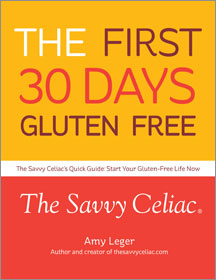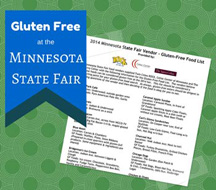A recent article in the New York Times poured the spotlight on the high price of gluten-free food! Why is it that gluten-free food is so much more than mainstream food? If you don’t know the diet, consider this: Kraft Macaroni and Cheese costs about $1.00 per box. A similar sized box of Annie’s Gluten-Free Macaroni & Cheese in my local store costs over $3.00 and Trader Joe’s GF Mac and Cheese costs $1.99. Even with the Trader Joe’s version, the gluten-free price difference is 99%.
I’m not sure if anyone actually ever expects gluten free food — like the mac and cheese — to ever cost exactly the same as the mass-produced products made by huge companies like Kraft. In many cases, companies are using higher-quality ingredients like quinoa, brown rice and flax seed to bring up the nutritional value. But a 100% – 200% percent price difference is tough to accept — especially when you’re new to the diet.
The New York Times article brought out an issue I mentioned in a post last spring that awareness of celiac and possible mainstreaming (and price reduction) of gluten-free food won’t have a chance of happening without drug company support.
“Some doctors blame drug makers, in part, for the lack of awareness and the lack of support. ‘The drug makers have not been interested in celiac because, until very recently, there have been no medications to treat it,’ said Dr. Peter Green, director of the Celiac Disease Center at Columbia University. ‘And since drug makers are responsible for so much of the education that doctors receive, the medical community is largely unaware of the disease.’” — New York Times
There are current drug trials underway which could change the tide with celiac disease awareness.
Saving money on gluten-free food
The New York Times article gave props to glutenfreeonashoestring.com and celiacchicks.com — both are bloggers on celiac disease — and offered some suggestions doing gluten-free food on a budget.
“Nicole Hunn, who cooks gluten-free meals for her family of five and just started the Web site glutenfreeonashoestring.com, avoids mixes, which she says are expensive and not that tasty, and instead bakes with an all-purpose gluten-free flour from a company called Bob’s Red Mill, which can be used in place of wheat flour in standard recipes.” — New York Times
The article also suggested checking out Trader Joe’s. I agree. I can get gluten-free macaroni and cheese for $1.99 a box. But I can also get gluten-free brown rice spaghetti and other noodles for $1.99 per bag. My daughter can’t tell the difference between these noodles and the more expensive alternative Tinkyada. Trader Joe’s also has a significant gluten-free listing on their website which you can print and bring with you to the store.
The article also mentioned doing the tax deduction for prescribed foods. I’d love to hear from people who do this because I don’t know anyone who takes the time to figure out the details on this and how to compare gluten-free food with gluten food. In other words what do I compare a loaf of gluten-free bread to? The generic white bread I buy for the rest of my family which is a buck, or a fancier bread that’s more expensive? My head hurts just thinking about it.
Here are other suggestions from my perspective:
- Buy in bulk. Annie’s Macaroni and Cheese comes down to $2.69 per box when you buy a case of 12 at Amazon.com for $32.31 (it also had “Free Super Saver Shipping”).
- Create your own gluten-free flour mix. I use the Bette Hagman mix of rice flour, potato starch and tapioca starch. I buy all of those flours at Asian food markets, where they are much cheaper. You can also find glutinous (sweet) rice flour that is called for in certain recipes.
If you have other great tips, feel free to share on this site! And take time to read this NY Times article…its a good one!



2 Responses to “Added Cost of Gluten-Free Food”
Trackbacks/Pingbacks
Leave a Reply